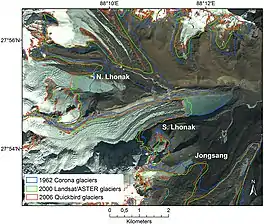| South Lhonak Lake | |
|---|---|
 From 1962 to 2006, a close-up view of changes in the glacier area surrounding the North and South Lhonak glaciers, highlighting changes in the proglacial lakes.[1] | |
| Coordinates | 27°56′50.93″N 88°19′53.54″E / 27.9474806°N 88.3315389°E |
| Type | Glacial, moraine-dammed |
| Primary inflows | Lhonak Glacier |
| Basin countries | India |
| Max. length | 1.98 km (1.23 mi) |
| Max. width | 0.45 km (0.28 mi) |
| Surface area | 1.26 km2 (0.49 sq mi) |
| Max. depth | 79.24 m (260.0 ft) |
| Surface elevation | 5,200 m (17,100 ft) |
South Lhonak Lake is a glacial-moraine-dammed lake, located in Sikkim's far northwestern region.[2] It is one of the fastest expanding lakes in the Sikkim Himalaya region, and one of the 14 potentially dangerous lakes susceptible to Glacial lake outburst flood (GLOFs).[3][4]
Location
The lake is located at 5,200 m (17,100 ft) above sea level. It formed due to the melting of the Lhonak glacier.[5]
Rapid growth
The lake is rapidly growing in size in an abnormally rapid manner due to the melting of the lake's associated South Lhonak glacier and additional melt water from the adjacent North Lhonak and main Lhonak glaciers.[6]
According to the declassified CORONA data from 1962, which was then collected by the Central Intelligence Agency and the United States Air Force between 1960 and 1972 as a part of America's first space reconnaissance program, the lake first appeared as a supraglacial lake at the glacier's snout on November 24, 1962.[7] The first occurrence of a separate lake was identified in the 1977 Landsat program's multispectral scanner (MSS) data. The lake's area was also traced using MSS data and the glacier's retreat. The lake had an area of 17.54 hectares in 1977 and was connected to the glacier terminal. Later, the lake's areal extent was determined using 1989, 2002, and 2008 temporal satellite data.[7] Between 1977 and 2008, the lake's surface area rose by 81.1 hectares.[7]
2023 outburst flood
In October 2023, heavy rains caused the swollen lake to breach its embankments and cause a severe flood in the Teesta river basin, causing widespread property damage and killing at least 40 people.[8]
Further reading
- Hazra, P., & Krishna, A. P. (2021, July). AHP Based Assessment of Glof Susceptibility of South Lhonak Glacial Lake, Sikkim Himalaya, India. In 2021 IEEE International Geoscience and Remote Sensing Symposium IGARSS (pp. 5489-5492). IEEE. doi:10.1109/IGARSS47720.2021.9553439.
See also
References
- ↑ Racoviteanu, A.E.; Arnaud, Y.; Williams, M.W.; Manley, M.F. (2015). "Spatial patterns in glacier characteristics and area changes from 1962 to 2006 in the Kanchenjunga–Sikkim area, eastern Himalaya". The Cryosphere. 9 (2): 505–523. Bibcode:2015TCry....9..505R. doi:10.5194/tc-9-505-2015. ISSN 1994-0424.
- ↑ Sattar, Ashim; Goswami, Ajanta; Kulkarni, Anil V. (2019-06-10). "Hydrodynamic moraine-breach modeling and outburst flood routing - A hazard assessment of the South Lhonak lake, Sikkim". Science of the Total Environment. 668: 362–378. doi:10.1016/j.scitotenv.2019.02.388. ISSN 0048-9697. PMID 30852213. S2CID 73726939.
- ↑ "Glacial lake keeps disaster managers on toes in Sikkim". www.downtoearth.org.in. Retrieved 2022-04-27.
- ↑ Sattar, Ashim; Goswami, Ajanta; Kulkarni, Anil. V.; Emmer, Adam; Haritashya, Umesh K.; Allen, Simon; Frey, Holger; Huggel, Christian (2021-09-01). "Future Glacial Lake Outburst Flood (GLOF) hazard of the South Lhonak Lake, Sikkim Himalaya". Geomorphology. 388: 107783. Bibcode:2021Geomo.38807783S. doi:10.1016/j.geomorph.2021.107783. ISSN 0169-555X. S2CID 236237797.
- ↑ Sharma, R. K.; Pradhan, Pranay; Sharma, N. P.; Shrestha, D. G. (2018). "Remote sensing and in situ-based assessment of rapidly growing South Lhonak glacial lake in eastern Himalaya, India". Natural Hazards. 93 (1): 393–409. doi:10.1007/s11069-018-3305-0. S2CID 134820367.
- ↑ "NMSHE: National Mission For Sustaining The Himalayan Ecosystem". knowledgeportal-nmshe.in. Retrieved 2022-04-27.
- 1 2 3 Raj, K. Babu Govindha; Remya, S. N.; Kumar, K. Vinod (2013). "Remote sensing-based hazard assessment of glacial lakes in Sikkim Himalaya". Current Science. 104 (3): 359–364. ISSN 0011-3891. JSTOR 24089638.
- ↑ Choudhury, Subrata Nag; Ahmed, Aftab (2023-10-06). "Death toll rises to 40 after glacial lake flooding in Indian Himalayas, dozens still missing". Reuters. Retrieved 2023-10-06.